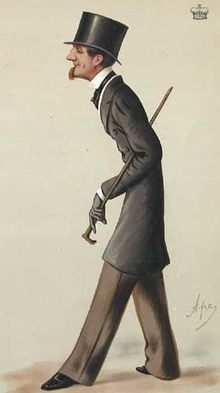John Thynne, 4th Marquess of Bath

John Alexander Thynne, 4th Marquess of Bath (born March 1, 1831 in Westminster , † April 20, 1896 in Venice ) was a British nobleman, politician and diplomat.
origin
John Thynne was the eldest son of Lord Henry Thynne and Harriet Baring, a daughter of Alexander Baring. His father inherited the extensive estates of the Thynne family and the title of Marquess of Bath in March 1837 after the childless death of his older brother and father , so that John carried the courtesy title Viscount Weymouth . However, his father himself died on June 24, 1837, so that John inherited his father at the age of six. He attended Eton College and then studied from May 31, 1849 at Christ Church College , Oxford .
Life
Bath soon began to play an important political role in South West England. He was Deputy Lieutenant of Somerset in 1853 and of Wiltshire in 1860 , in addition he was an officer in the militia and the yeomanry . From 1889 he was the first chairman of the newly formed Wiltshire County Council and Lord Lieutenant of Wiltshire.
In May 1858 he was sent to Lisbon as a British special ambassador and plenipotentiary for the wedding of the Portuguese King Peter V with Princess Stephanie von Hohenzollern-Sigmaringen . King Peter V awarded him the Order of Tower and Sword for this . Nine years later, in July 1867, Bath was again the British special ambassador on the occasion of the coronation of Emperor Franz Joseph I as King of Hungary. For this he received the Grand Cross of the Leopold Order . Politically, Bath was generally conservative, but he did not join any party. During the American Civil War he advocated the independence of the Confederate States , whose ambassador James Murray Mason he lodged in his country estate Longleat House . He was a staunch Anglo-Catholic and a fierce opponent of the Public Worship Regulation Act of 1874. He played an active political role, especially from 1876 to 1878, when the Ottoman Empire brought about a wave of outrage over the atrocities after the Bulgarian April Uprising came to the Bulgarian civilian population. He was one of the critics of the government under Disraeli , which saw itself to be the protector of the Ottoman Empire and followed a policy of silence towards the uprising in the Balkans. During this time, Longleat House served as the venue for numerous meetings and deliberations, which Gladstone and other leaders also attended. In 1880, after a trip to Bulgaria, Bath published his work Observations on Bulgarian Affairs .
In the 1870s, Bath had many interiors redesigned by Longleat in the style of the Italian Renaissance by John Crace . He was also curator of the National Portrait Gallery from 1874 to 1893 and from 1883 curator of the British Museum . In 1884 he became a member of the Academy of Belgrade and worked for the Historical Manuscripts Commission . He died while traveling in Venice and was buried in the family crypt in Longbridge Deverill .
Family and offspring
On August 20, 1861, he married Frances Isabella Catherine Vesey (1840-1915), the eldest daughter of Thomas Vesey, 3rd Viscount de Vesci and Emma Herbert. He had three sons and three daughters with her:
- Thomas Henry Thynne, 5th Marquess of Bath (1862–1946)
- Lady Alice Emma Thynne (around 1863–1942) ⚭ Sir Hugh Shaw-Stewart, 8th Baronet
- Lady Katherine Georgina Louisa Thynne (1865–1933) ⚭ Evelyn Baring, 1st Earl of Cromer
- Lady Beatrice Thynne (1867-1941)
- Lord John Boteville Thynne (1867-1887)
- Lord Alexander George Thynne (1873-1918)
His net worth was reported to be over £ 272,049 on his death. His eldest son Thomas inherited his titles.
literature
- G. Le G. Norgate, HCG Matthew: Thynne, John Alexander, fourth marquess of Bath (1831-1896). In: Henry Colin Gray Matthew, Brian Harrison (Eds.): Oxford Dictionary of National Biography , from the earliest times to the year 2000 (ODNB). Oxford University Press, Oxford 2004, ISBN 0-19-861411-X , ( oxforddnb.com license required ), as of 2004
Web links
- John Alexander Thynne, 4th Marquess of Bath on thepeerage.com , accessed November 2, 2015.
Individual evidence
- ↑ Thomas E. Sebrell: Persuading John Bull. Union and Confederate propaganda in Britain, 1860-1865 . Lexington Books, Lanham 2104. ISBN 978-0-7391-8511-7 , p. 132.
- ↑ Hugh Montgomery-Massingberd; Christopher Simon Sykes: Great houses of England & Wales . King, London 1994. ISBN 1-85669-053-9 , p. 161.
| predecessor | Office | successor |
|---|---|---|
| Henry Thynne |
Marquess of Bath 1837-1896 |
Thomas Thynne |
| personal data | |
|---|---|
| SURNAME | Thynne, John, 4th Marquess of Bath |
| ALTERNATIVE NAMES | Thynne, John Alexander, 4th Marquess of Bath (full name); Weymouth, Lord John; Bath, John, 4th Marquess of |
| BRIEF DESCRIPTION | British nobleman, politician and diplomat |
| DATE OF BIRTH | March 1, 1831 |
| PLACE OF BIRTH | Westminster (London) |
| DATE OF DEATH | April 20, 1896 |
| Place of death | Venice |